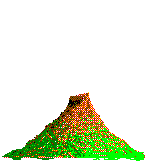



What are Volcanos?
Volcanos are eruptions from deep inside the earth that are great explosions on the earths surface. Most volcanos occur on the edge of the continental plates of the world. A circle of volcanos called the Pacific Ring of Fire, is located around the edge of the pacific ocean. It is called the Ring of fire because it is a ring of volcanos that have either erupted, dormant, or are just waiting to erupt. The theory of Plate Tectonics is used to explain the relationship between volcanos and earthquakes.
When volcanos erupt a type of material called magma is pushed to the top and is released into the air or just moves over the side of the volcano. When the magma is opened into the air it becomes lava. There are many different types of lava. There is liquid lava, which can be fast moving or slow moving. The rocks you see are made of cooled lava. And sometimes you may find a gemstone or a type of jewel in the slow cooling lava.
Three types of volcanos
are shield , cinder cone, and compost. A shield volcano is not steep and
doesn't explode like everyone thinks all volcanos do. It actually lets
the lava flow from the top making it look like a huge shield made of rock.
A cinder cone volcano is the kind of volcano that everyone thinks of when
you say volcano. What it does is it explodes from the top sending lava
shooting into the air. This type of explosion makes it a very steep
volcano. And the last type of volcano is a compost volcano. A compost volcano
is a combination of a shield and cinder cone volcanos. It can either be
steep or not so steep. It can also exploded from the top or just let the
lava flow from the top.
Volcanos and their history:
Mount St. Helen's
MT.St. Helen's
is located in the United States in Washington. Its is on the the greatest
known volcanos in the U.S. Mt St. Helen's has forests and fields on its
base. It also has glaciers and snow. The 1980 eruption cleared a lot of
the vegetation out and some is still growing or recovering back.
Mt. St. Helen's is a stator volcano. The 1980 eruption sent tons of ash
into the air . The ash covered more than 150 square miles of land. The
ash that Mt St. Helen's pushed out even pushed logs into the lake called
Spirit Lake. Spirit Lake is still partly covered in logs from the eruption
of Mt St. Helen's.
Devils Tower
Devils Tower is another well known volcano. Devils Tower is steep and is
mostly made up of and igneous rock body. Its steep body is made from slow
oozing magma. The rock around devils tower is about 40 millions years old
and this rock is called Phondile.
Devils Tower rises as high as 1,253 feet. It also towers above the nearby
river called Belle Founche River. Devils Tower is located in Wyoming
and some say the long ago Devils tower gave refuge to seven little girls
that where being chased by bears. There is an abundant amount of wildlife
by Devils tower. Devils Tower is a national monument.
Hazards of volcanos
Hazards of
volcanos come in any shape, size and detail. You would be putting your
self in a volcanic hazards by living next to an active volcano, because
when that volcanos erupts you would be in its direct path. Ay area potential
close to an active volcano would have more damage than that of an area
farther away from the volcano. Another hazard of volcanos is when the magazines
put pictures of beautiful lava flowing from the volcano, which would convince
you that living next to a volcano is safe. For more information
click on Hazards
Causes of Volcanos
Causes of
volcanic eruptions happens when the hot material under ground is pushed
up. Then when the heat and pressure become so hot the magma of hot material
bursts from the top. Another way an eruptions can occur is when the magma
just flows over the edge. These are ways that different eruptions can occur.
For more information click on Causes
Signs of eruptions
The
signs that an eruptions may occur can happen in many different ways. One
way it can erupt is that it you can feel small earthquakes. Another way
is that you can see steam coming from the surface. And another way is that
there are types of instruments that can tell when an eruption is
about to occur. All these ways can help save lives and money. Click here
for more information: Signs



![]()